Outback coastal camping at Warroora Station, WA
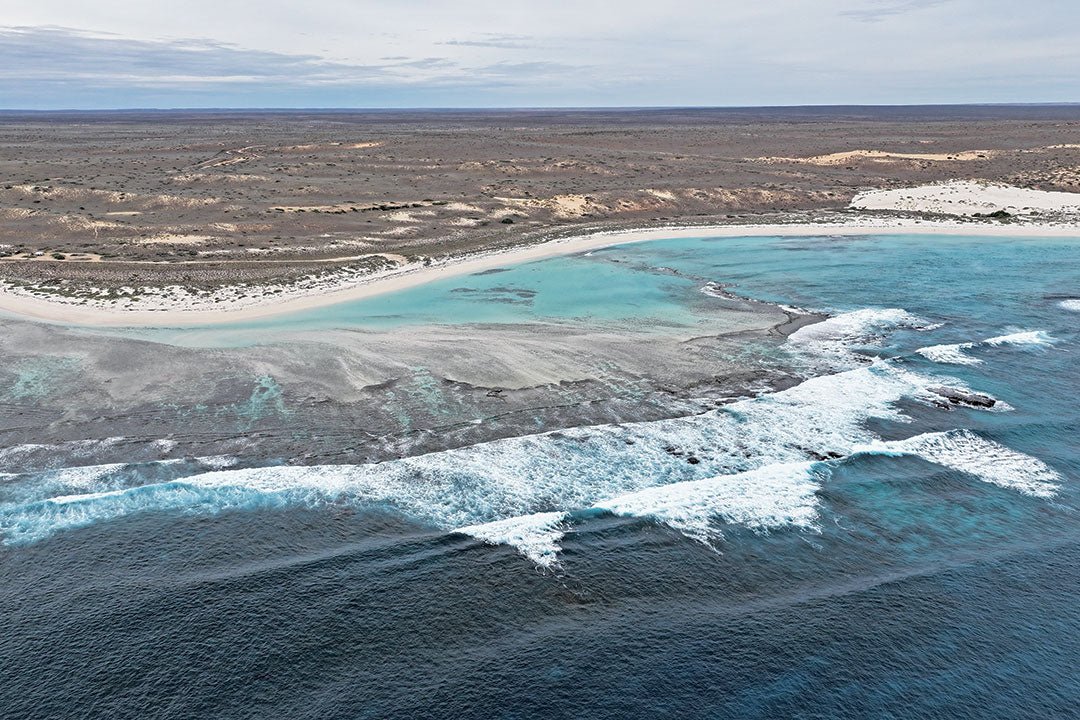
How does leaving the caravan park crowd behind to go off-grid at a coastal eco camp sound?
Our destination is Sandy Point, one of a dozen coastal camps at Warroora Station (pronounced Warra). This working cattle station and eco camp is located about 12-hours driving from Perth, halfway between Carnarvon and Exmouth, on WA's Coral Coast. It's a two-day, overnight scenic drive for us from Dunsborough and my husband and I shared the driving.
We hitched the Lotus Trooper to our 200 Series Toyota LandCruiser, loaded the rooftop tinny, numerous surfboards and three kelpies. The suspension on the Cruiser is fitted with a Lovells GVM and BTC Upgrade, increasing our carrying and towing capacity. It’s a bonus for this self-appointed ‘camp princess’ who loves her extra creature comforts in the Lotus, especially when off-grid.
We broke the trip with an overnight stop at Galena Bridge, north of Northampton. This picturesque free campsite on the Murchison River has drop toilets and dump points. It has plenty of places north and south of the bridge to pull up well off the Northwest Coastal Highway. Hitting the road early from here meant the highway was quieter and gifted us a pretty sunrise that blushed the salmon gums a soft pink.
The dawn start meant we made it to Carnarvon for additional fresh provisions before heading on to arrive at Warroora while there was enough daylight to set up camp. Add a sunset ocean dip to wash off the long road trip and we were instantly happy campers.
There are two entrances on the Minilya-Exmouth Road to Warroora. We took the northern entrance as it’s quicker to camp. The sign warned us that the inconspicuous dirt track was unsealed and corrugated. The bumpy road headed west through red dirt and in sections, I felt like a human cocktail, shaken, not stirred. It was slow going, even with the offroad capability of our van. Depending on the season, the road may look like you can get away with not deflating your tyres but don’t be fooled. It gets soft and there is a steep, sandy incline closer to camp.
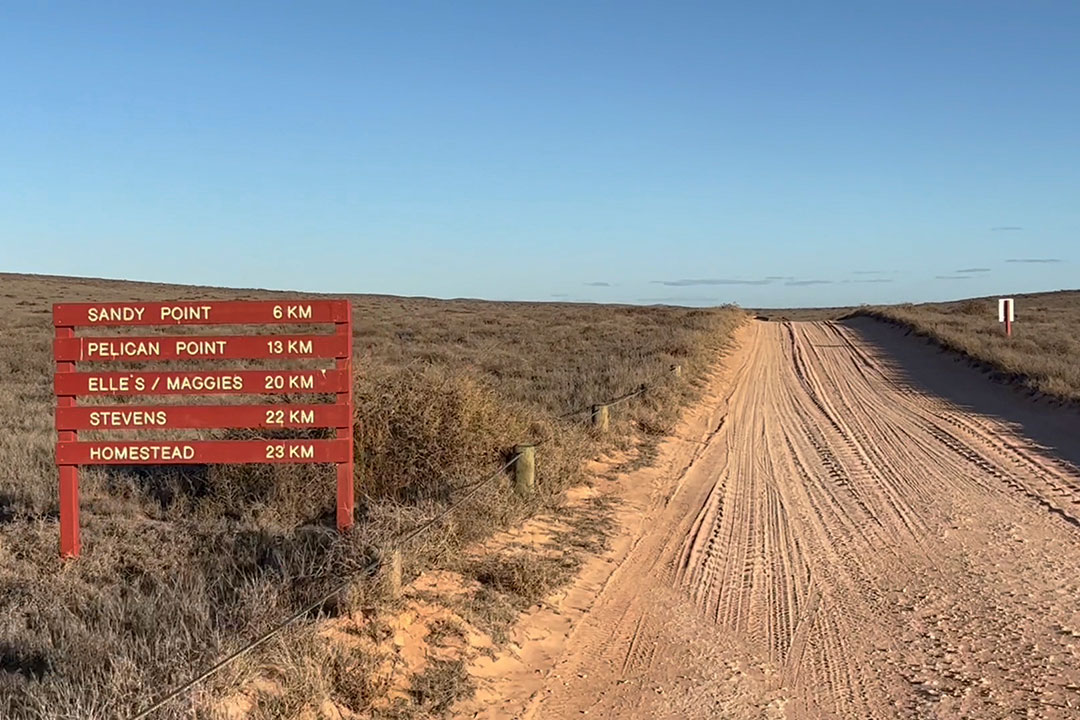
As we bounced, the vista delivered a distant, painted sailor blue horizon. The road is positioned just above sea level and offers a spectacular first impression of this secluded area in Western Australia’s Gascoyne region. Around the final sandy bend, we were a stone’s throw from the ocean’s edge and moments from camp. It was here we got bogged. We further deflated our tyres (but not our spirits) and positioned the bog mats. The dogs watched us wryly, seemingly wondering why we were on our hands and knees digging. With a spray of sand and gusto, we pulled our hotel on wheels free and made it to camp.
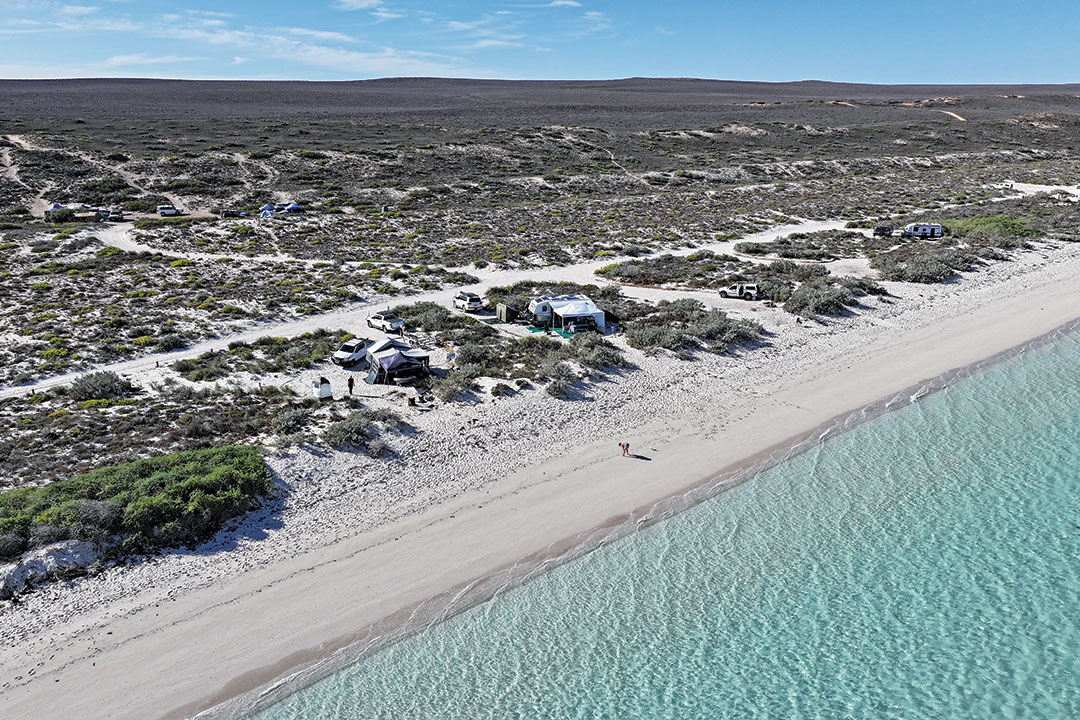
Eco camping at Ningaloo (Nyinggulu)
Positioned on the edge of Ningaloo Marine Park, beach camping in this area was originally managed by individual pastoral leases. In 2015, the WA State Government created a joint plan with the Department of Biodiversity, Conservation and Attractions (DBCA) and the Gnulli Native Title claimants along the Nyinggulu Coast to protect and conserve this area and the coastal campsites from Carnarvon through to Exmouth. Bookings are now made through Parks and Wildlife for 11 campgrounds at Warroora. The twelfth campground at the homestead is managed via the station.
The 300km Ningaloo Reef system is the world’s largest fringing coral reef and one of the longest near shore reef systems. It is home to a healthy abundance of sea life, with more than 700 reef fish species and 300 documented coral species. With whale sharks, dugongs and humpback whales on display, the region attracts upwards of 200,000 visitors each year.
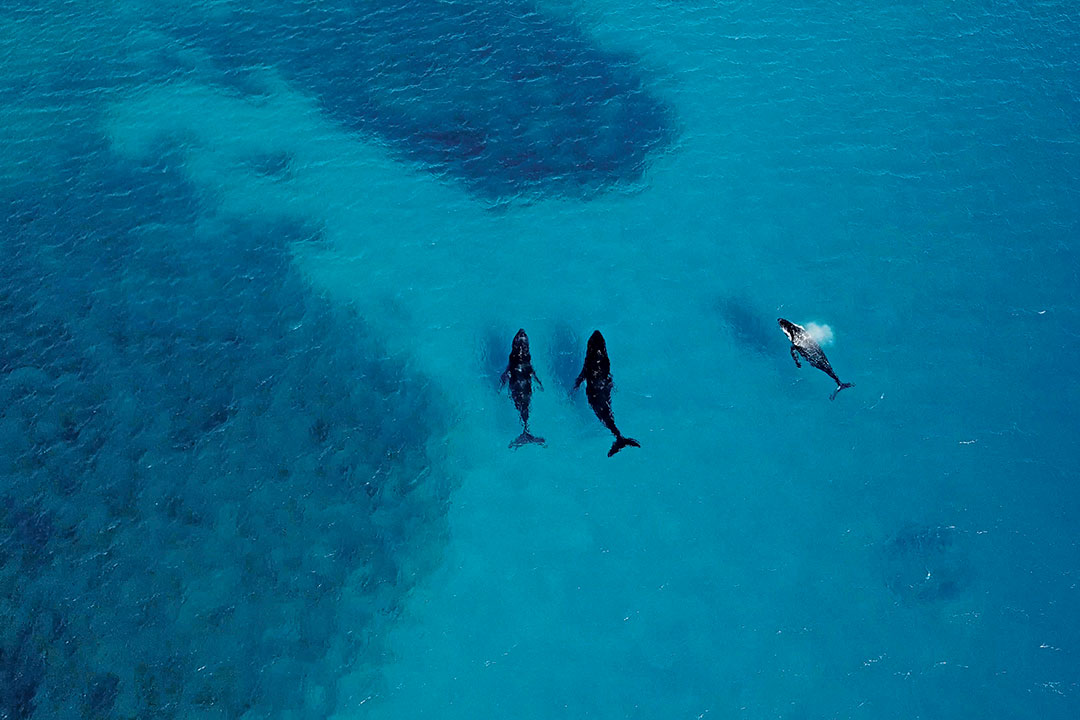
Yet, at this eco camp you can avoid the crowds. The Warroora coast runs for 50km and campgrounds are well spread out with varying numbers of sites. At Sandy Point, our pre-booked site was one of just 14 campsites and located just metres from the shore. For $8 per adult per night, you have direct beach access and ocean views. The trade-off is you must be completely self-sufficient. There’s no power, potable water or amenities here. Portable chemical cassette toilets are compulsory and camp hosts will check you have one. Surprisingly, seasonal fires are permitted if you have your own firepit, and nothing feels more outback than an open fire under a star-studded sky. This is wilderness camping at its best and an extraordinary way to discover the beauty of Australia.
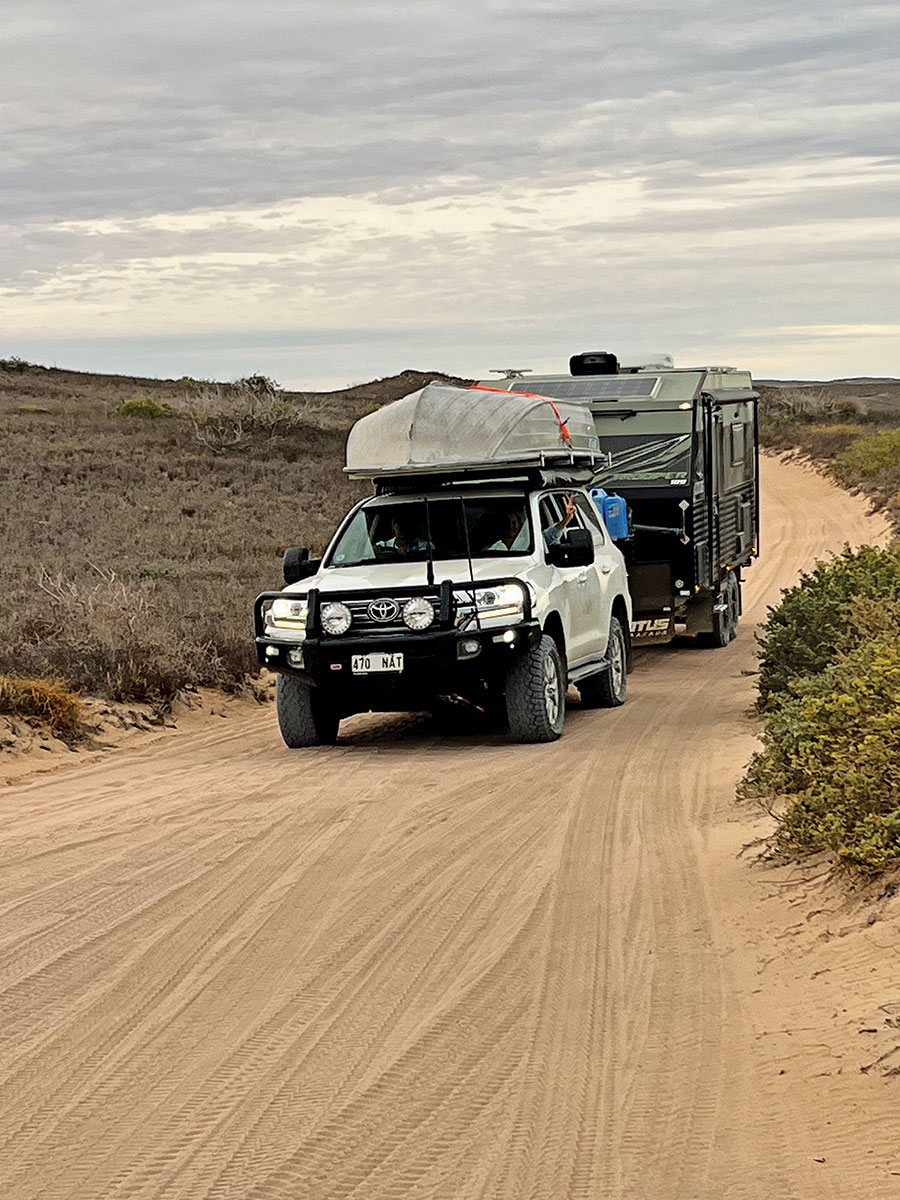
Sandy Point sanctuary
In a generous gesture from Mother Nature, the outer reef at Sandy Point sweeps around the bay. It creates a rugged wall of safe sanctuary for all that harbours within. Anchored here was a pair of crisp white catamarans floating upon a turquoise sea. They were the only traffic on the water, and I couldn’t help but think this was possibly one of the most private and idyllic places to moor, just as our beachside site was to camp.
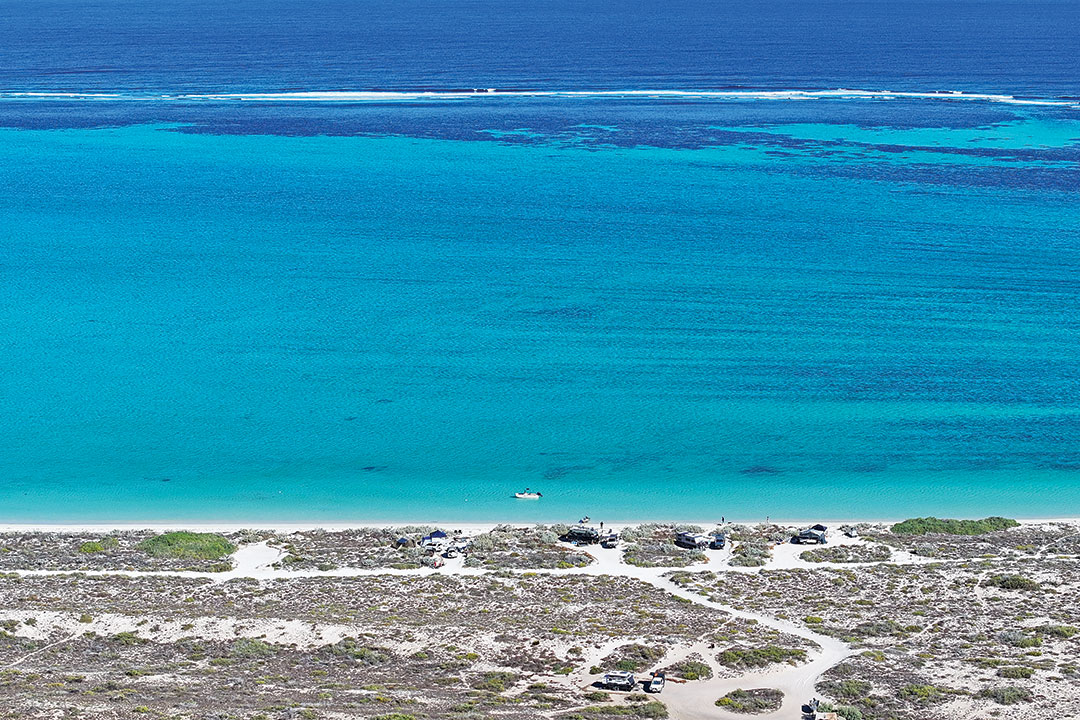
A pelican skimmed across the surface. The block of black and white colouring was a checkerboard against a sea of azure blue. Sandy Point is a pelican sanctuary, and this lone bird reminded me that the ocean in front is also a sanctuary zone. There’s no fishing permitted from boats directly in front of camp. Shore fishing is allowed, and a dawn cast one morning delivered a fat and shiny thread fin salmon for breakfast. Taken with strong hot tea and toast for company, it is the taste of a long-ago childhood summer holiday.
If you have a tinny, you can motor about 1km to the north and about 1km offshore to fish for spangled emperor, golden trevally and squid. Be mindful of the swell that can roll in through the channel in the reef. It’s rare to come in without something for dinner and we fished for what we needed that day. Boat launching is from the beach, and we took a decent sand anchor to moor close to shore for the duration of our stay.
Mother Nature's kaleidoscope
As the sun climbed higher, it lit the sky an eye squinting blue. We fired up our dinghy and headed out to the inside edge of the outer reef. We scrambled over the edge of the boat, mask and snorkel in place, to float above a kaleidoscope of sea life. It wasn’t the invigorating ocean that took my breath away, but this snorkelling spot. Outcrops of huge bone-coloured coral blossom like giant cauliflowers, probing finger coral with tiny blue manicured tips reached out and soft homewares pink seagrass danced and swayed with the firm current. I stopped kicking and let the current carry me along, floating above an underwater world that swished and popped like rice bubbles. There was all manner of reef-dwelling fish in a riot of colour and shapes. Plump spangled emperor swam with confidence below me, black sea cucumbers lay lazily on the seabed and an assembly of zebra striped reef fish created a crosswalk as I swam.

Schools of yellow reef fish, the colour of storybook sunshine, reminded me that happiness is, in fact, a colour. But it was the schools of iridescent blue reef fish that were my favourite. They darted in and out of the staghorn coral, playing a game of hide and seek. Their schools were so large, and they were all around me. I truly felt like I was a part of their cluster rather than a voyeur to this perfectly curated aquarium. Depending on which way they caught the sun, they mimicked a chameleon as they changed from blue to purple in a miracle from nature.
Later, as I sat in my camp chair, I listened to the gentle lull of the ocean kissing the shore. This is a great place to ditch your smartphone. There is limited service here anyway. A turtle popped its huge prehistoric head above the surface. Seeing me, he bobbed down again, a nosy neighbour caught peeking. Closer to shore, a school of whitebait fish shimmered. The sun caught their scales, a magic trick reflecting silver mirrored light. They flashed in a frenzy as two reef sharks powered in, scraping their bellies on the shore, in a race for dinner. My G&T caught the last light of the fat yellow sun as it melted like a blob of butter into the sea.
Exploring Warroora Station
There are numerous bays and white sandy beaches to explore along this coast, all via 4WD. We packed a picnic lunch of fresh fish tacos and headed to Elle’s Beach, named after Elle McPherson, who visited in 1997. This remote stretch of beach with icing sugar white sand and aquamarine water can have strong currents so exercise caution. At low tide the rock pools are accessible from the shoreline. These rugged craters, formed thousands of years ago, created gorgeous patterns to explore.
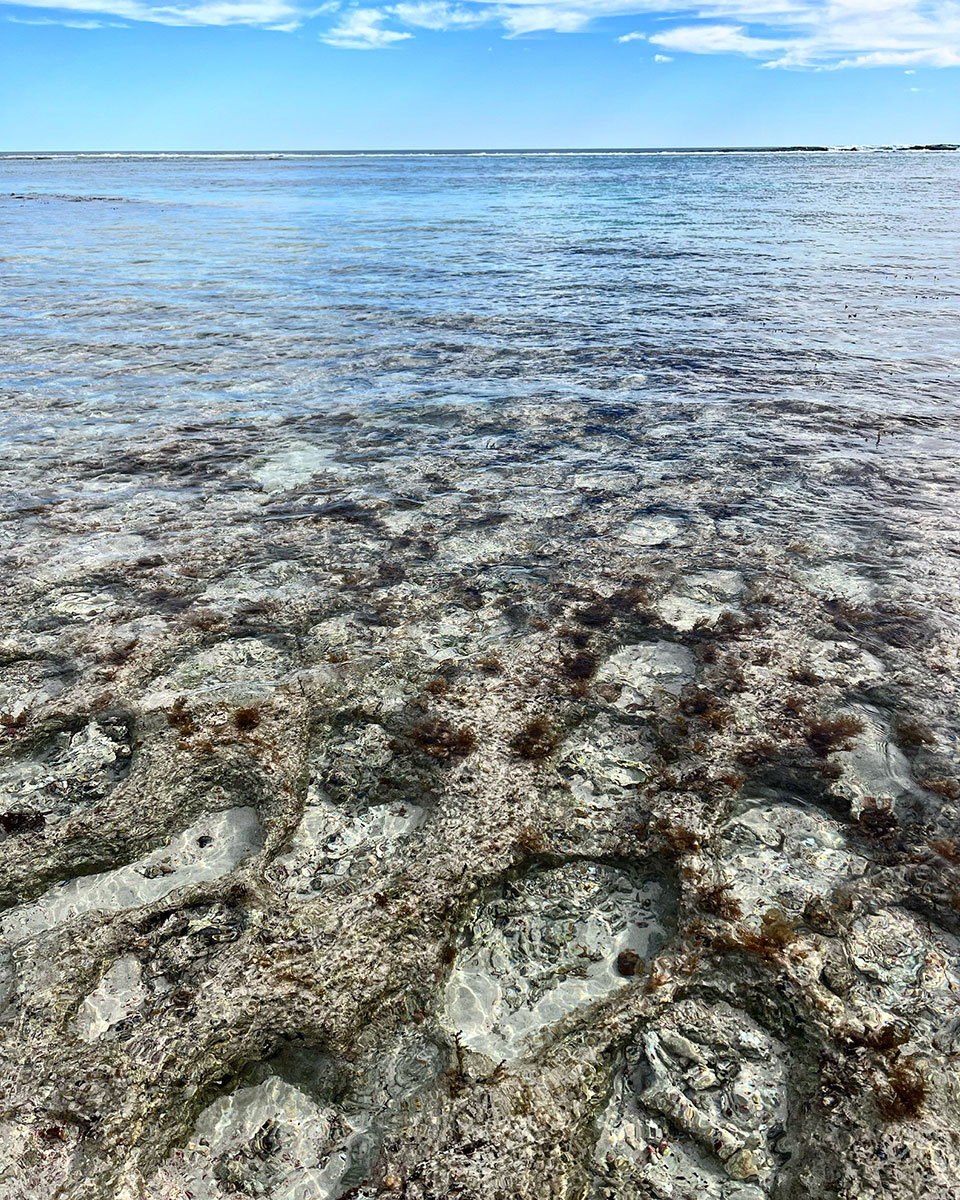
Another day we decided to pop to the shop for an ice cream. This entails a 30-minute 4WD to the homestead, so we bumped our way along the corrugations and headed to Steven’s Camp first for a dip. Snorkelling here from the beach had us up close and staring into the giant alien-like eyes of cuttlefish. Their tentacles swayed in the current as they ventured out from under the reef, watching us.
The wonder of Warroora
In the afternoon, when the wind at camp drops, the ocean becomes as fluid as quicksilver. We launched our stand-up paddle boards and glided above a transparent sea of clear water with a white sandy seabed. It’s like looking through a pane glass window. We passed over huge manta rays hiding under a blanket of sand like ghosts, with just their dark eyes peering out. The LAGO (late afternoon glass off) provided a magical lead crystal surface to reflect the rich golden light that lingered orange, matching our open fire, long after the sun had been put to bed.
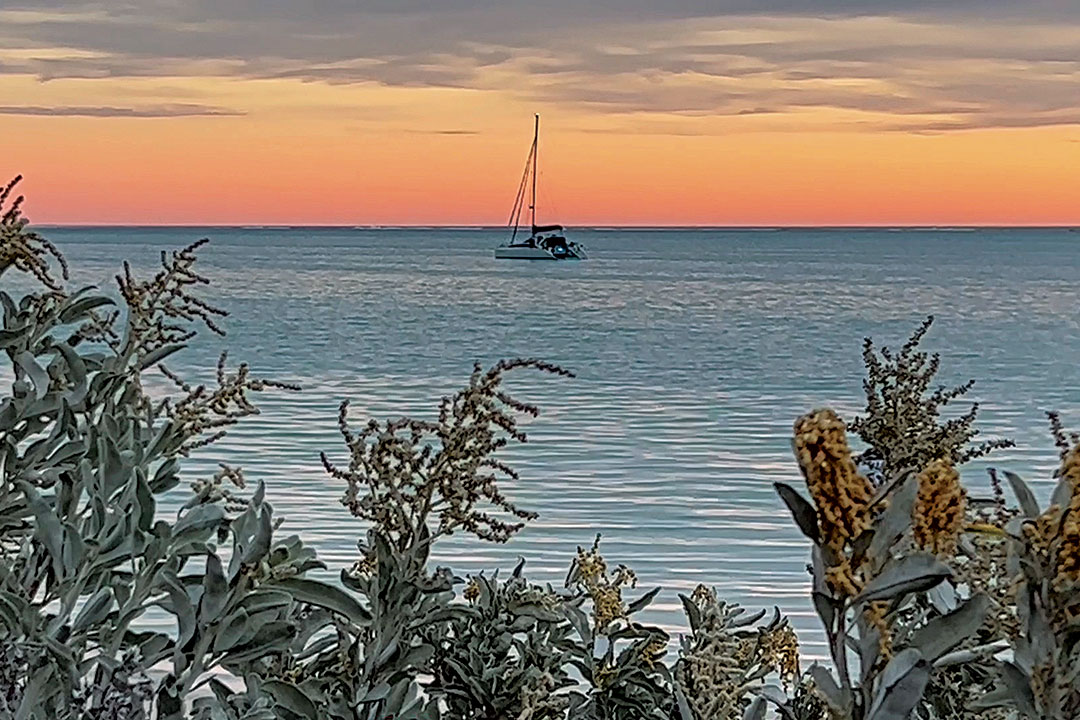
If you haven’t gasped at a northwest sky, you should probably put it on your list. It feels like you have fallen into an Australian landscape painting. Standing under an expansive canopy of cloudless blue nothingness makes your heart stretch wide open.
Camped out under the striking magical night sky, the constellations burned bright. Venus and Mars looked down upon us, a beacon to pin dreams upon. On our last night, salty and pleasingly tired from two weeks of ocean air, I watched a shooting star traverse the sky, burning a trail of fizzing bright light. I found myself wishing for longevity for this fragile ecosystem that is Ningaloo (Nyinggulu) Marine Park. I hope that it shall continue to thrive with wild beauty, and we can find a way to exist alongside, enjoying its raw wonder as custodians of this gift from Mother Nature.
Travel planner
Getting there
- About 12 hours drive from Perth.
- Perth to Geraldton via Brand Highway, Geraldton to Carnarvon and then on to Minilya Bridge Roadhouse, via North West Coastal Highway.
- Minilya Bridge Roadhouse to the turn-off at Warroora Northern Road via the Minilya-Exmouth Road. *Top up your fuel at Minilya.
- The Warroora Northern Road is about 30km past the Warroora Homestead turn off.
Staying
- $8 per adult per night W: parkstay.dbca.wa.gov.au
- Book ahead. Bookings can be made 180 days in advance.
- Warroora Homestead Campground from $34 per night; the Homestead also has a range of non-camping options.
Playing
- Snorkelling access from both beach and boat at most beaches.
- Sandy Point, Stevens and Lagoon have a great waves for surfing.
- Fishing is good to great and should land you a feed, so don't forget to bring your fishing gear.
- Book a whale shark charter from Coral Bay or Exmouth (1 March to 31 August).
Knowing
- Best time to visit is March-October. April and May generally have less wind but factor in wind at any time.
- Snorkel on low tide for better clarity.
- Portable chemical toilets are compulsory. Generators permitted 9am to 5pm. Campfires permitted within a contained firepit. Bring your own wood.
- Coral Bay is 45 minutes away to replenish fresh produce, drinking water and fuel.
- Dogs permitted on a leash. 1080 is a real poison risk.
- Camp hosts are at each campground with local advice and satellite phones in case of an emergency.
- Always bring the right safety and recovery gear when camping in remote areas, particularly when there's sand involved
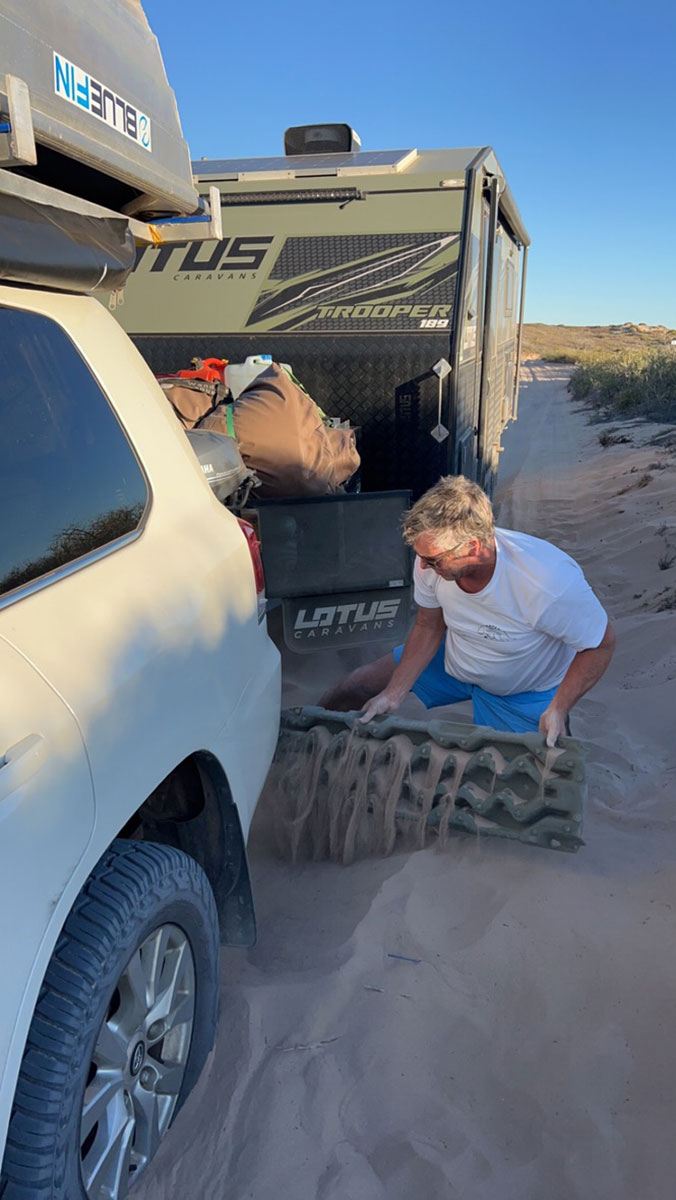
Discover more of WA's hidden gems
WA is a wonderland of natural beauty, and while you're in the area don't miss visiting Cape Range National Park. This national park is an ideal spot for nature lovers and features plenty of walking trails, fishing spots, fantastic camping spots and much more.
And if you need a break from all the quiet serenity, head further north along the peninsula to Exmouth, where you'll find caravan parks and all the supplies you need to keep your authentic outback experience going.
THE NEXT STEP
Are you ready to experience the freedom of the open road? Don't wait - Find your dream getaway now!







